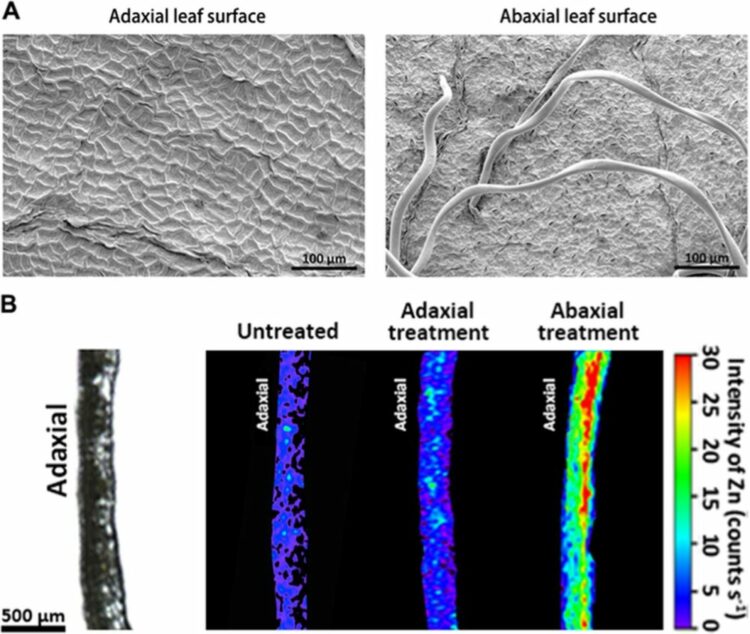Tracking Foliar Zinc Absorption in Apple Trees
09/01/2020

Different efficiencies of zinc (Zn) absorption in adaxial and abaxial leaf surfaces. Scanning electron micrographs (row A) of leaf surfaces of apple mature leaves, showing that mature apple leaves have a heterogeneous topography between adaxial (left) and abaxial (right) leaf surfaces. Micro-X-ray fluorescence mapping (row B) of zinc through leaf cross sections after foliar application. In each section, the adaxial side is to the left.
[Reprinted under a Creative Commons license (CC BY) from Xie et al. 2020. DOI:10.1038/s41438-020-00369-y]
The Summary
Zinc deficiency in the soil can affect plant health and lead to poor yields, especially in fruit crops. Zinc is a vital micronutrient involved in various cellular processes and it plays a critical role in maintaining the structure of various plant proteins, including transcription factors. Therefore, an interruption or decline in zinc supply substantially affects vegetative development and reproductive success in subsequent years.
Zinc fertilization is standard agricultural practice for fruit trees, but achieving successful mitigation can be challenging, particularly in alkaline soils characterized by strong zinc fixation capacity. Nutrient supplementation usually requires application of large quantities of fertilizer, which is cost prohibitive. It is also frequently ineffective for fruit tree crops because the root systems penetrate deep into soil layers where zinc mobility is often poor.
In contrast to soil amendments, foliar nutrient application guarantees rapid and targeted uptake via direct delivery to plant tissues during vital growth stages. Foliar nutrient penetration is a complex process that relies on plant leaf surface characteristics, the physicochemical properties of chemical nutrients, supplement type and concentration, and environmental conditions.
In a study using synchrotron-based X-ray fluorescence microscopy (XRF) on SSRL’s beamline 2-3, Tian et al. tracked in vivo localization of zinc after foliar fertilizer treatment of apple plants (Malus domestica Borkh.). Apple was selected because of its high sensitivity to zinc deficiency and the vulnerability of apple orchards in areas with calcareous and salt-affected soils, resulting in significant yield losses and fruit quality deterioration.
The researchers found that foliar-applied zinc absorption was largely dependent on plant leaf surface characteristics. In particular, abaxial leaf surfaces—the undersides of leaves—absorbed significantly greater zinc concentrations than adaxial leaf surfaces.
High-resolution elemental maps revealed that the cell wall’s high binding capacity for zinc contributed to its limited penetration across epidermal cells. Trichome density and stomatal aperture had opposite effects on zinc fertilizer penetration: a relatively high density of trichomes increased the hydrophobicity of leaves, whereas the presence of stomata facilitated foliar zinc penetration.
The results indicate that the extent of zinc mobilization is a key factor in its foliar uptake. Low levels of zinc promoted the accumulation of other mineral elements in treated leaves, and the complexation of zinc with phytic acid likely occurred due to exposure to high-zinc conditions.
The study provides direct visual evidence for zinc penetration process across the leaf surface, which is important for the development of strategies for zinc biofortification in fruit-bearing crops.
Related Links
References
Xie, R., et al. 2020. “Penetration of Foliar-Applied Zn and Its Impact on Apple Plant Nutrition Status: In Vivo Evaluation by Synchrotron-Based X-Ray Fluorescence Microscopy,” Horticulture Research 7, 147. [DOI:10.1038/s41438-020-00369-y]
